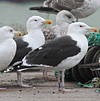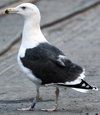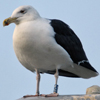 Great Black-backed Gull (Larus marinus)
Great Black-backed Gull (Larus marinus)
(last update: July 12, 2015)
Great Black-backed Gull adult January
DISTRIBUTION AND MIGRATION
Population 200,000 pairs. Breeds on sandy islands and along rocky coasts; prefers flat-topped stacks. Local on salt marsh, lakes or urban areas. Opportunistic feeder, locally considered a threat towards other seabirds, especially eiders Somateria. In winter mainly coastal, but usually also occurs inland in small numbers.
Some spread in twentieth century, with expansion of breeding range to Spitsbergen and Iceland 1921, France 1925, Denmark 1930, Germany 1984, Netherlands 1993. Population stable or slightly declining Norway, Great Britain, Iceland and W Sweden, increasing Baltic, Denmark and France (Hagemeher & Blair 1997).
European and Atlantic population in late 1990s (in pairs): Great Britain 23,000; Iceland 20,000-25,000 (30,000-50,000 in 1970s); Spitsbergen 20-100 (in 1980); W and SE Greenland 10,000; France 3,000 (1,200 mid-1990s); Germany 1-10; Netherlands 10-15; Denmark 1,500-1,600 (464 1974); Norway 40,000; Sweden 15,000-20,000 (7,300 mid-1970s); Finland 2,800
(strong increase); European Russia 8,200—10,000 (4,100 Murmansk coast and some hundreds Gulf of Finland); Estonia 5,000 (Moller 1978, Cramp & Simmons 1983, Risberg 1990, Qershaug et al. 1994, Tucker & Heath 1994, del Hoyo et al. 1996, Hagemeger & Blair 1997, Grell 1998, Vaisinen et aL 1998, van den Berg & Bosman 1999, Bijlsma et al. 2001).
In N America it is increasing in numbers and extending its breeding range. In New England 30 pairs 1930, 12,400 1972. First bred Maine 1928, Massachusetts 1931, New York 1940, Great Lakes 1954, New Jersey 1966. Breeds S to N Carolina. E North American population 17,415 pairs 1983. Summer flocks max. 800 Maryland. Vagrant W to Alaska (del Hoyo et al. 1996).
Migration variable: High Arctic populations completely migratory; sedentary in S part of breeding range. Populations of N Russia / N Norway leave breeding sites from Jul, migrating W to S along Norwegian coast to main winter areas in North Sea region; fewer Great Britain W to Ireland, even fewer S to Bay of Biscay, Iberian and Moroccan coastlines (recorded S to Casablanca) and W Mediterranean. Many W and S Norwegian birds migrate to NE England, where main arrival Sep (Cramp & Simmons 1983, Coulson et al 1992).
Migration in S Baltic peaks Oct—Nov with day-count >100 Swedish E coast. In S Scandinavia / Waddensee vanguards from Jul, flocks of hundreds (mainly younger birds) late Jul-mid-Aug; peak late Aug-Oct with flocks >3,000 in German Waddensee. In S part of wintering range peak Nov-Feb. Several thousands in Dutch Waddensee.
NW European winter population 480,000. Baltic birds winter between Baltic and Kattegat / North Sea, mainly Danish Belts and Kattegat, where mingling with Danish, S Norwegian and W Swedish population. Danish winter population 3,000-4,000. Netherlands winter population 60,000-90,000 at sea and 4,000-16,000 along coasts. Some W Scandinavian birds migrate to North Sea S to English Channel. Scarce C Europe, mainly Oct-Apr; some N Scandinavian, Finnish and N Russian birds move east-south-east; ringing recoveries of Moscow birds from E Europe S to former Yugoslavia, Komi and Volga.
Scarce, but increasing winter visitor E Europe to C European lakes and N Atlantic S to the Azores, occasional Morocco (Glutz von Blotzheim & Bauer 1982, Cramp & Simmons 1983, Malling Olsen 1992, Breife et al. 1993, Jensen 1993, Rose & Scott 1994, Clarke 1999, Bijlsma et al. 2001).
British population mainly resident, but some spread of especially younger birds to Ireland; few recoveries abroad E to Denmark and Norway and S to Biscay coast of France, Iberian Peninsula and Morocco.
Faeroe and Iceland birds mainly resident; winter influxes to Faeroe Islands may be of both Icelandic and N Scandinavian origin; Iceland birds have been recovered in Great Britain (mainly W coast). Very common Iceland in winter; along SW coast gatherings of thousands
around fishing harbours. Greenland birds probably perform short-distance migration to S of breeding quarters. Birds from Murmansk, Iceland and Denmark recovered E Greenland in winter (Salomonsen 1967, Cramp & Simmons 1983, Lack 1986, Boertmann 1994, K T. Pedersen in litt.).
Spring migration Mar-Apr. Younger birds found between breeding and wintering areas, but many stay in winter quarters throughout summer, as indicated by several Danish recoveries of birds from Sweden and Finland summering in Denmark (Cramp & Simmons 1983).
Vagrant C and S Europe, E Mediterranean, Bulgaria, Turkey, Madeira, Canary and Cape Verde Islands, Mauritania, N Red Sea, Middle East to Persian Gulf (Glutz von Blotzheim & Bauer 1982, Martins 1989, Shirihai 1996b).
Wintering area of NE American population is the Atlantic seaboard, mainly between Newfoundland New Jersey, with gatherings of up to 3,000 in autumn Newfoundland and of 2,275 at Cape May, New Jersey in winter. Increasing S of New Jersey, where formerly rare.
Flocks of some hundreds noted Ontario and 1,000 Lake Erie, Mid-west. Scarce S to W Indies and Gulf of Mexico; vagrant West Coast of USA, Great Plains, Mexico and Japan (Cramp & Simmons 1983, Sibley 1993, Dunn 1997, Enticott & Tipling 1997, H. H. Nielsen pers comm).
(Malling Olsen, K. & Larsson, H. 2004 Gulls of Europe, Asia and North America. London: Christopher Helm).
 Great Black-backed Gull (Larus marinus) JL03 2006, 2009, 2013 & 2016, Boulogne sur Mer, France (50.44 N - 01.35 E). Picture Jean-Michel Sauvage.
Great Black-backed Gull (Larus marinus) JL03 2006, 2009, 2013 & 2016, Boulogne sur Mer, France (50.44 N - 01.35 E). Picture Jean-Michel Sauvage. Great Black-backed Gull (Larus marinus) J5RP April 2008, December 2011, October 2012 & January 2015,
Great Black-backed Gull (Larus marinus) J5RP April 2008, December 2011, October 2012 & January 2015, Boulogne sur Mer, France (50.44 N - 01.35 E). Picture Jean-Michel Sauvage.
 Great Black-backed Gull (Larus marinus) JA639 6cy, January 10 2013, Boulogne sur Mer, France. Picture Jean-Michel Sauvage.
Great Black-backed Gull (Larus marinus) JA639 6cy, January 10 2013, Boulogne sur Mer, France. Picture Jean-Michel Sauvage. Great Black-backed Gull (Larus marinus) SVS 9159239 5cy-9cy, March 2012-April 2016, Boulogne-sur-Mer, France. Picture Jean-Michel Sauvage.
Great Black-backed Gull (Larus marinus) SVS 9159239 5cy-9cy, March 2012-April 2016, Boulogne-sur-Mer, France. Picture Jean-Michel Sauvage. Great Black-backed Gull (Larus marinus) 6cy NLA 6038628 January 13 2012, IJmuiden, the Netherlands.
Great Black-backed Gull (Larus marinus) 6cy NLA 6038628 January 13 2012, IJmuiden, the Netherlands. Great Black-backed Gull (Larus marinus) adult x xxx5627 January 09 2013, Boulogne sur Mer, France. Picture Jean-Michel Sauvage
Great Black-backed Gull (Larus marinus) adult x xxx5627 January 09 2013, Boulogne sur Mer, France. Picture Jean-Michel Sauvage Great Black-backed Gull (Larus marinus) 1AS 5CY, January 02 2014, Howth, Dublin, Ireland. Picture: Graham Prole.
Great Black-backed Gull (Larus marinus) 1AS 5CY, January 02 2014, Howth, Dublin, Ireland. Picture: Graham Prole. Great Black-backed Gull (Larus marinus) 1EJ 6CY, January 27 2015, Bulloch Harbour, Ireland. Picture: Graham Prole.
Great Black-backed Gull (Larus marinus) 1EJ 6CY, January 27 2015, Bulloch Harbour, Ireland. Picture: Graham Prole. Great Black-backed Gull (Larus marinus) 2CN 6CY, January & April 2014, Howth, Dublin, Ireland. Picture: Graham Prole.
Great Black-backed Gull (Larus marinus) 2CN 6CY, January & April 2014, Howth, Dublin, Ireland. Picture: Graham Prole. Great
Black-backed Gull (Larus marinus) 4E4 8CY, January 28 2013, Sandy Point State Park. Picture: Suzanne Sullivan.
Great
Black-backed Gull (Larus marinus) 4E4 8CY, January 28 2013, Sandy Point State Park. Picture: Suzanne Sullivan. Great
Black-backed Gull (Larus marinus) 7E3 adult, January 22 2012, Point Pleasant beach, NJ. Picture: Alex Tongas.
Great
Black-backed Gull (Larus marinus) 7E3 adult, January 22 2012, Point Pleasant beach, NJ. Picture: Alex Tongas. Great
Black-backed Gull (Larus marinus) ACT adult, January 12 2012, Sable Island, NS. Picture: Sable Island banding team.
Great
Black-backed Gull (Larus marinus) ACT adult, January 12 2012, Sable Island, NS. Picture: Sable Island banding team. Great Black-backed Gull (Larus marinus) G7AT adult, January 03 2018, Boulogne sur Mer, France (50.44 N - 01.35 E). Picture Jean-Michel Sauvage.
Great Black-backed Gull (Larus marinus) G7AT adult, January 03 2018, Boulogne sur Mer, France (50.44 N - 01.35 E). Picture Jean-Michel Sauvage.Great
Black-backed Gull L. marinus adult, winters of 2009-2011, Acer port, Israel. Images Amir Ben Dov.
 Great Black-backed Gull (Larus marinus) adult, January 13 2012, IJmuiden, the Netherlands.
Great Black-backed Gull (Larus marinus) adult, January 13 2012, IJmuiden, the Netherlands.
 Great Black-backed Gull (Larus marinus) adult, January 13 2012, IJmuiden, the Netherlands.
Great Black-backed Gull (Larus marinus) adult, January 13 2012, IJmuiden, the Netherlands.
 Great Black-backed Gull (Larus marinus) adult, January 13 2012, IJmuiden, the Netherlands.
Great Black-backed Gull (Larus marinus) adult, January 13 2012, IJmuiden, the Netherlands.
 Great Black-backed Gull (Larus marinus) adult, January 13 2012, IJmuiden, the Netherlands.
Great Black-backed Gull (Larus marinus) adult, January 13 2012, IJmuiden, the Netherlands.
 Great Black-backed Gull (Larus marinus) adult, January 13 2012, IJmuiden, the Netherlands.
Great Black-backed Gull (Larus marinus) adult, January 13 2012, IJmuiden, the Netherlands.
 Great Black-backed Gull (Larus marinus) adult, January 13 2012, IJmuiden, the Netherlands.
Great Black-backed Gull (Larus marinus) adult, January 13 2012, IJmuiden, the Netherlands.
 Great Black-backed Gull (Larus marinus) adult, January 13 2012, IJmuiden, the Netherlands.
Great Black-backed Gull (Larus marinus) adult, January 13 2012, IJmuiden, the Netherlands. Great Black-backed Gull (Larus marinus) adult, January 13 2012, IJmuiden, the Netherlands.
Great Black-backed Gull (Larus marinus) adult, January 13 2012, IJmuiden, the Netherlands. Great Black-backed Gull (Larus marinus) adult, January 13 2012, IJmuiden, the Netherlands.
Great Black-backed Gull (Larus marinus) adult, January 13 2012, IJmuiden, the Netherlands. Great Black-backed Gull (Larus marinus) adult, January 13 2012, IJmuiden, the Netherlands.
Great Black-backed Gull (Larus marinus) adult, January 13 2012, IJmuiden, the Netherlands.
Arrested moult?
 Great Black-backed Gull (Larus marinus) adult, January 13 2012, IJmuiden, the Netherlands.
Great Black-backed Gull (Larus marinus) adult, January 13 2012, IJmuiden, the Netherlands. Great Black-backed Gull (Larus marinus) adult, January 13 2012, IJmuiden, the Netherlands.
Great Black-backed Gull (Larus marinus) adult, January 13 2012, IJmuiden, the Netherlands. Great Black-backed Gull (Larus marinus) adult, January 13 2012, IJmuiden, the Netherlands.
Great Black-backed Gull (Larus marinus) adult, January 13 2012, IJmuiden, the Netherlands. Great Black-backed Gull (Larus marinus) adult, January 13 2012, IJmuiden, the Netherlands.
Great Black-backed Gull (Larus marinus) adult, January 13 2012, IJmuiden, the Netherlands. Great Black-backed Gull (Larus marinus) adult, January 13 2012, IJmuiden, the Netherlands.
Great Black-backed Gull (Larus marinus) adult, January 13 2012, IJmuiden, the Netherlands. Great Black-backed Gull (Larus marinus) adult, January 15 2012, IJmuiden, the Netherlands.
Great Black-backed Gull (Larus marinus) adult, January 15 2012, IJmuiden, the Netherlands. Great Black-backed Gull (Larus marinus) adult, January 15 2012, IJmuiden, the Netherlands.
Great Black-backed Gull (Larus marinus) adult, January 15 2012, IJmuiden, the Netherlands.